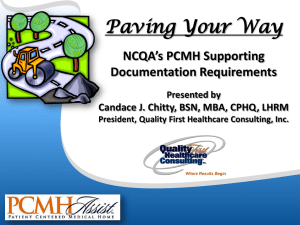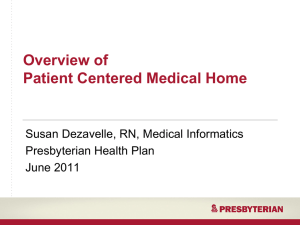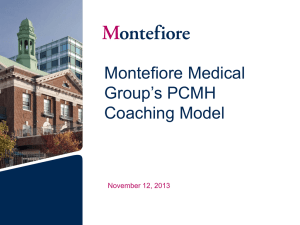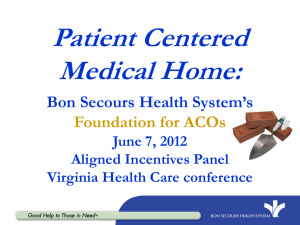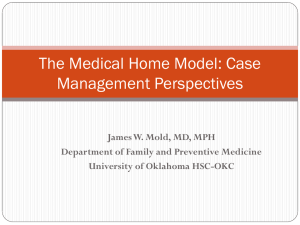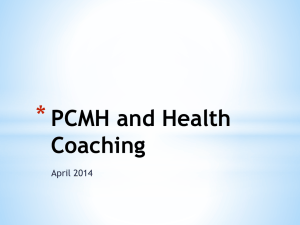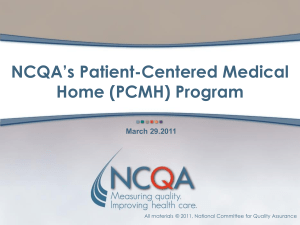PRESENTATION TITLE HERE YOUR NAME YOUR TITLE
advertisement
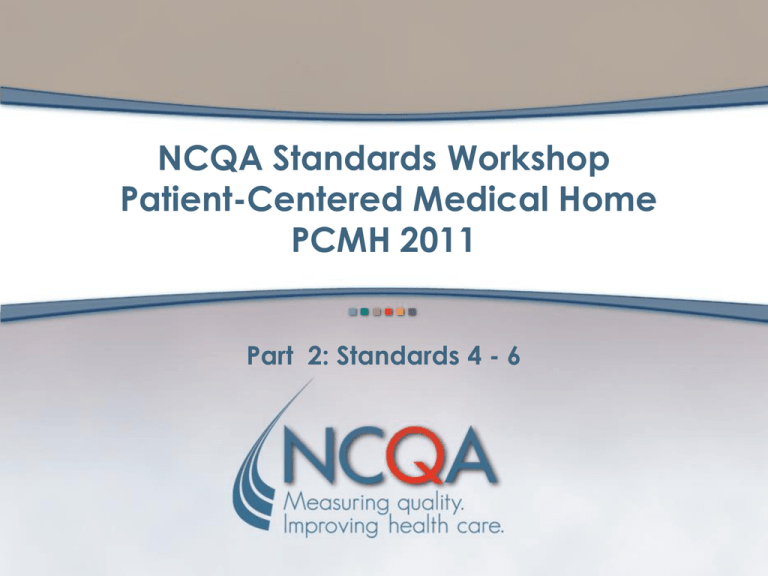
NCQA Standards Workshop Patient-Centered Medical Home PCMH 2011 Part 2: Standards 4 - 6 Agenda: Part 2 • Content of PCMH 2011 – Standards 4 – 6 – Documentation examples* • Survey processes – Upgrades, Renewals, Add-on Surveys – Multi-site requirements * Examples in the presentation only illustrate the element intent. They are NOT definitive nor the only methods of documenting how the elements may be met. Patient-Centered Medical Home Standards Workshop 2011 2 PCMH 2011 Content and Scoring PCMH1: Enhance Access and Continuity Pts A. B. C. D. E. F. 4 4 2 2 2 2 G. Access During Office Hours** After-Hours Access Electronic Access Continuity Medical Home Responsibilities Culturally and Linguistically Appropriate Services Practice Team 4 20 PCMH2: Identify and Manage Patient Populations Pts A. B. C. D. 3 4 4 5 PCMH4: Provide Self-Care Support and Community Resources Pts A. B. 6 3 Support Self-Care Process** Provide Referrals to Community Resources 9 PCMH5: Track and Coordinate Care Pts A. B. C. 6 6 6 Test Tracking and Follow-Up Referral Tracking and Follow-Up** Coordinate with Facilities/Care Transitions 18 PCMH6: Measure and Improve Performance Pts 16 A. B. C. 4 4 4 PCMH3: Plan and Manage Care Pts D. A. B. C. D. E. 4 3 4 3 3 E. F. Patient Information Clinical Data Comprehensive Health Assessment Use Data for Population Management** Implement Evidence-Based Guidelines Identify High-Risk Patients Care Management** Manage Medications Use Electronic Prescribing 17 Measure Performance Measure Patient/Family Experience Implement Continuously Quality Improvement** Demonstrate Continuous Quality Improvement Report Performance Report Data Externally 3 3 2 20 **Must Pass Elements Patient-Centered Medical Home Standards Workshop 2011 3 PCMH 4: Provide Self-Care Support and Community Resources Intent of Standard Meaningful Use Criteria • Practice provides self• Use EHR to identify patients care tools and support to who need education patients resources • Practice identifies and refers patients to community resources Patient-Centered Medical Home Standards Workshop 2011 4 PCMH 4: Provide Self-Care Support and Community Resources Elements • PCMH4A: Support Self-Care Process – MUST PASS • PCMH4B: Provide Referrals to Community Resources Patient-Centered Medical Home Standards Workshop 2011 5 PCMH4A: Support Self-Care Process Practice conducts activities to support patients in selfmanagement: 1. Provides education resources or refers at least 50% of patients to educational resources 2. Uses EHR to identify education resources and provide them to 10% of patients** 3. Collaborates with at least 50% of patients to develop and document self-management plans and goals-CRITICAL FACTOR 4. Documents self-management abilities for at least 50% of patients 5. Provides self-management result recording tools to at least 50% of patients 6. Counsels at least 50% of patients on adopting health lifestyles ** Menu Meaningful Use Requirement Patient-Centered Medical Home Standards Workshop 2011 6 PCMH 4A: Scoring and Documentation • MUST PASS • 6 Points • Scoring – – – – – 5-6 factors (including factor 3)= 100% 4 factors (including factor 3)= 75% 3 factors (including factor 3)= 50% 1-2 factors= 25% 0 factors = 0% • Data Sources: – Report from electronic system or submission of Record Review Workbook Patient-Centered Medical Home Standards Workshop 2011 7 PCMH 4A: Example Support Self-Care Process Response Options Yes No Not Used Patient-Centered Medical Home Standards Workshop 2011 8 PCMH 4B: Provide Referrals to Community Resources Practice supports patients who need access to community resources: 1. Maintains current resource list covering five (5) community service areas (e.g. smoking cessation, weight loss, parenting, dental, transportation, fall prevention, meal support) 2. Tracks referrals provided to patients 3. Arranges for or provides treatment for mental health/substance abuse disorders 4. Offers opportunities for health education and peer support Patient-Centered Medical Home Standards Workshop 2011 9 PCMH 4B: Scoring and Documentation • 3 Points • Scoring – – – – – 4 factors = 100% 3 factors = 75% 2 factors = 50% 1 factor = 25% 0 factors = 0% • Data Sources: – List of community services or agencies – Referral log or report covering at least one month – Processes to provide/arrange for mental health/substance abuse treatment and health education support Patient-Centered Medical Home Standards Workshop 2011 10 PCMH 5: Track and Coordinate Care Intent of Standard Meaningful Use Criteria • Track and follow-up on lab and imaging results • Track and follow-up on referrals • Coordinates care received at hospitals and other facilities • Incorporate clinical lab test results into the medical record • Electronically exchange of clinical information with other clinicians and facilities • Provide electronic summary of care record for referrals and care transitions Patient-Centered Medical Home Standards Workshop 2011 11 PCMH 5: Track and Coordinate Care Elements • PCMH5A: Test Tracking and Follow-Up • PCMH5B: Referral Tracking and Follow-Up – MUST PASS • PCMH5C: Coordinate with Facilities and Care Transitions Patient-Centered Medical Home Standards Workshop 2011 12 PCMH 5A: Test Tracking and Follow-Up Practice has documented process for and demonstrates: 1. Tracks lab tests and flags and follows-up on overdue results – CRITICAL FACTOR 2. Tracks imaging tests and flags and follows-up on overdue results – CRITICAL FACTOR 3. Flags abnormal lab results 4. Flags abnormal imaging results 5. Notifies patients of normal and abnormal lab/imaging results 6. Follows up on newborn screening (NA for adults) 7. Electronically order and retrieve lab tests and results 8. Electronically order and retrieve imaging tests and results 9. Electronically incorporates at least 40% of lab results in records** 10.Electronically incorporate imaging test results into records **Menu Meaningful Use Requirement Patient-Centered Medical Home Standards Workshop 2011 13 PCMH 5A: Scoring and Documentation • 6 Points • Scoring – – – – 8-10 factors (including factors 1 and 2) = 100% 6-7 factors (including factors 1 and 2) = 75% 4-5 factors (including factors 1 and 2) = 50% Fewer than 3 factors = 0% • Data Sources: – Process or procedure for staff and an example of how factors 1-6 are met – Electronic system examples for factors 7-10 Patient-Centered Medical Home Standards Workshop 2011 14 PCMH 5A: Example Comment Text All tests (laboratory and imaging) are tracked electronically. The EMR has several functions which will track all tests, show results, date results received, shows appropriate ranges, and highlights abnormal results by providing a color visual cue for clinicians. The EMR also provides functionality for printing out results letters, and tracking verbal delivery of results through the messaging system. In addition, there are several reports used on a daily basis to ensure that all tests that have been ordered, are resulted. These reports show the status of the test, whether a result has been received or is pending, and if received, whether or not the clinician has verified (seen) the result. It also provides an aging of the test, showing the user how long it has been outstanding. For additional detail and to view samples of this, please refer to the document titled "Results Tracking" which provides screen shots. Also see the document titled "Results documentation" for additional screen shots, details on how the system functions, and examples of how abnormal results are flagged. Patient-Centered Medical Home Standards Workshop 2011 15 PCMH 5A: Example Test Tracking Log DATA COLLECTED Patient name DOB Provider Order date Test ordered Urgency Date results received Results normal/abnormal Date results to provider Date results to patient Patient-Centered Medical Home Standards Workshop 2011 16 PCMH 5A: Example Electronic Test Tracking All lab and imaging tests are tracked until results are available Overdue results are flagged Abnormal results are flagged Practice tracks: Date ordered Overdue Abnormal Priority Patient name Provider Order description Last appointment Next appointment Patient-Centered Medical Home Standards Workshop 2011 17 PCMH 5A: Example Notifies Patient of Abnormal Results Patient-Centered Medical Home Standards Workshop 2011 18 PCMH 5A: Example EHR Order Screens Laboratory Test Order Screen Radiology Test Order Screen Patient-Centered Medical Home Standards Workshop 2011 19 PCMH 5B: Referral Tracking & Follow-Up Practice coordinates referrals: 1. Provides specialist with reason and key information for the referral 2. Tracks referral status 3. Follows up to obtain specialist reports 4. Has agreements with specialists documented in the record 5. Asks patients about self-referrals and requests specialist reports 6. Demonstrates electronic exchange of key clinical information* 7. Provides electronic summary of care for more than 50% of referrals** * Core Meaningful Use Requirement **Menu Meaningful Use Requirement Patient-Centered Medical Home Standards Workshop 2011 20 PCMH 5B: Scoring and Documentation • MUST PASS • 6 Points • Scoring – – – – – 5-7 factors= 100% 4 factors = 75% 3 factors = 50% 1-2 factors= 25% 0 factors = 0% • Data Sources: – Reports or logs demonstrating tracking system data collection – Documented processes with three examples – Reports from electronic system showing frequency of information exchange and summary of care records Patient-Centered Medical Home Standards Workshop 2011 21 PCMH 5B: Example Referral Tracking Log Patient-Centered Medical Home Standards Workshop 2011 22 PCMH 5B: Example Referral Tracking Tracking Table Includes Referring physician Referral date Patient name/DOB Facility/physician Diagnosis/reason for referral Appointment date Insurance information/if pre-authorization needed Stat? Received report Report overdue? Notified patient Patient-Centered Medical Home Standards Workshop 2011 23 PCMH 5C: Coordinate with Facilities and Care Transitions Practice systematically demonstrates: 1. 2. 3. 4. 5. 6. Process to identify patients with hospital admissions or ED visits Process to share clinical information with hospital/ED Process to obtain patient discharge summaries Process to contact patients for follow-up care after discharge Process to exchange patient information with hospital It collaborates with patient to develop written care plan for transitions from pediatric to adult care (NA for adults) 7. Electronic exchange of key clinical information with facilities* 8. Provides electronic summary of care for more than 50% of transitions of care** * Core Meaningful Use Requirement **Menu Meaningful Use Requirement Patient-Centered Medical Home Standards Workshop 2011 24 PCMH 5C: Scoring and Documentation • 6 Points • Scoring: – – – – – 5-8 factors= 100% 4 factors= 75% 2-3 factors= 50% 1 factor= 25% 0 factors = 0% • Data Sources: – Documented processes for patient identification, providing clinical information, systematic follow-up, obtaining discharge summaries and two-way communication – Copy of a written transition care plan – Reports illustrating electronic information exchange – Electronic report summarizing >50% care transitions Patient-Centered Medical Home Standards Workshop 2011 25 PCMH 5C: Example Identifying Patients in Facilities Practice receives admission reports electronically from hospital Patient-Centered Medical Home Standards Workshop 2011 26 PCMH 5C: Example Follow-Up Care after Hospital Admission Patient-Centered Medical Home Standards Workshop 2011 27 PCMH 6: Measure and Improve Performance Intent of Standard Meaningful Use Criteria • Measure preventive, chronic and acute care; utilization affecting costs; patient experience and report performance • Use and monitor effectiveness of quality improvement process Report: • Ambulatory quality measures to CMS • Immunization data to registries • Syndromic surveillance data to public health agencies Patient-Centered Medical Home Standards Workshop 2011 28 PCMH 6: Measure and Improve Performance Elements • PCMH6A: Measure Performance • PCMH6B: Measure Patient/Family Experience • PCMH6C: Implement Continuous Quality Improvement – MUST PASS • PCMH6D: Demonstrate Continuous Quality Improvement • PCMH6E: Report Performance • PCMH6F: Report Data Externally Patient-Centered Medical Home Standards Workshop 2011 29 PCMH 6A: Measure Performance Practice measures or receives the following data: 1. 2. 3. 4. Three (3) preventive care measures Three (3) chronic or acute care measures Two (2) utilization measures affecting health care costs Vulnerable population data Patient-Centered Medical Home Standards Workshop 2011 30 PCMH 6A: Scoring and Documentation • 4 Points • Scoring – – – – 4 factors= 100% 2-3 factors = 75% 1 factor 25% 0 factors = 0% • Data Sources: – Reports showing performance Patient-Centered Medical Home Standards Workshop 2011 31 PCMH 6A: Example Chronic Care Clinical Measures Patient-Centered Medical Home Standards Workshop 2011 32 NCQA Clinical Program Recognition Where Can it Be Used to Meet Elements? • NCQA Clinical Recognition Programs – Diabetes Recognition Program (DRP) – Heart/Stroke Recognition Program (HSRP) – Back Pain Recognition Program (BPRP) • Credit for Clinical Program Recognition may be used for meeting requirements in 7 elements if majority of physicians are Recognized: – PCMH 3A, 3C (for selected conditions used for survey) – PCMH 6A, 6C, 6E, 6F Patient-Centered Medical Home Standards Workshop 2011 33 PCMH 6B: Measure Patient/Family Experience Practice obtains feedback on patient experience with the practice and their care: 1. Practice conducts survey measuring experience on at least three (3) of the following: access, communication, coordination, whole-person care 2. Practice uses PCMH CAHPS-CG survey tool 3. Practice obtains feedback from vulnerable populations 4. Practice obtains feedback through qualitative means Patient-Centered Medical Home Standards Workshop 2011 34 PCMH6B: Scoring and Documentation • 4 Points • Scoring – – – – – 4 factors = 100% 3 factors = 75% 2 factors= 50% 1 factor = 25% 0 factors = 0% • Data Sources: – Reports showing results of patient feedback Patient-Centered Medical Home Standards Workshop 2011 35 PCMH6B: Example Patient Experience Survey Results Survey questions include: Access Communication Patient-Centered Medical Home Standards Workshop 2011 36 PCMH 6C: Implement Continuous Quality Improvement Practice uses ongoing quality improvement process: 1. Set goals and act to improve performance on three (3) measures from Element 6A 2. Set goals and act to improve performance on one (1) measure from Element 6B 3. Set goals and address at least one (1) identified disparity in care for vulnerable populations 4. Involve patients in QI teams or on the practice’s advisory council Patient-Centered Medical Home Standards Workshop 2011 37 PCMH 6C: Scoring and Documentation • Must Pass • 4 Points: – – – – 3-4 factors = 100% 2 factors= 50% 1 factor= 25% 0 factors = 0% • Data Sources: – Report or completed PCMH Quality Measurement and Improvement worksheet – Process demonstrating how it involves patients/families in QI teams or advisory council Patient-Centered Medical Home Standards Workshop 2011 38 PCMH 6C: Example NCQA Quality Measurement and Improvement Worksheet 2011 Clinical Activities Patient Feedback Other Area for Analysis Data Source or Measure Opportunity Identified Current Performance Performance Goal Action Taken and Date Patient-Centered Medical Home Standards Workshop 2011 39 PCMH 6D: Demonstrate Continuous Quality Improvement Practice demonstrates ongoing monitoring of the effectiveness of its improvement process: 1. 2. 3. 4. Tracks results over time Assesses effect of its actions Achieves improved performance on one measure Achieves improved performance on a second measure Patient-Centered Medical Home Standards Workshop 2011 40 PCMH 6D: Scoring and Documentation • 3 Points: – – – – – 4 factors= 100% 3 factors = 75% 2 factors= 50% 1 factor= 25% 0 factors = 0% • Data Sources: – Reports showing measures over time, recognition results or completed Quality Improvement Measurement and Improvement Worksheet Patient-Centered Medical Home Standards Workshop 2011 41 PCMH6D: Example Patient Survey Results Over Time Patient-Centered Medical Home Standards Workshop 2011 42 PCMH 6E: Report Performance Practice shares data from Element A and B: 1. Individual clinician results within the practice 2. Practice results within the practice 3. Individual clinician or practice results to patients or public Patient-Centered Medical Home Standards Workshop 2011 43 PCMH 6E: Scoring and Documentation • 3 Points: – – – – 3 factors= 100% 2 factors= 75% 1 factors= 50% 0 factors = 0% • Data Sources: – Reports (blinded) showing summary data and how it provides results within the practice – Example of patient/public report Patient-Centered Medical Home Standards Workshop 2011 44 PCMH 6E: Example Reporting by Clinician 1 2 3 4 5 6 Patient-Centered Medical Home Standards Workshop 2011 45 PCMH 6E: Example Reporting Across Practice(s) Shows data for multiple sites Patient-Centered Medical Home Standards Workshop 2011 46 PCMH 6F: Report Data Externally Practice electronically reports: 1. Ambulatory clinical quality measures to CMS* 2. Data to immunization registries or systems** 3. Syndromic surveillance data to public health agencies** *Core Meaningful Use Requirement **Menu Meaningful Use Requirement Patient-Centered Medical Home Standards Workshop 2011 47 PCMH 6F: Scoring and Documentation • 2 Points: – – – – 3 factors= 100% 2 factors= 75% 1 factor= 50% 0 factors = 0% • Data Sources: – Reports demonstrating data submission Patient-Centered Medical Home Standards Workshop 2011 48 Overview of Recognition Process NCQA • • • • • • • • Reviews submitted Survey Tool after all application information received: NCQA Agreement (contract with NCQA) and Business Associate Addendum (BAA), Application, Clinician information, Application fee Checks licensure of all clinicians Evaluates Survey Tool responses, documentation, and explanations Conducts 5% audit by email, teleconference, or on-site visit Executive reviewer conducts a secondary review Peer review by trained Recognition Program Oversight Committee (RP-ROC) member Issues final decision and status to the practice within 30 – 60 days Reports results • Recognition posted on NCQA Web site Not passed - not reported Mails PCMH certificate and Recognition packet Patient-Centered Medical Home Standards Workshop 2011 49 Add-On Surveys • When will a practice utilize an add-on survey? – Practices with Level 1 or 2 Recognition who want to increase their Level with additional documentation and scoring – Practice may submit an add-on survey anytime within the current Recognition period, application fee is discounted • Process – Complete application information from your online application account – NCQA merges data from previous Survey Tool into new PCMH Survey Tool and makes available to practice – Practice may change response in any element with score of <100%; no need to reattach already submitted documents – Once completed, practice uploads new documents and submits survey and payment • New status based on – Score achieved on saved scores and new assessment Patient-Centered Medical Home Standards Workshop 2011 50 What Are Multi-Site Surveys? • The multi-site application process is an option for organizations or medical practices that have 3 or more sites that share policies and procedures and electronic systems across all of their physician sites. • NCQA does not give organization-wide Recognition • Multi-site surveys enable practices to complete specified PCMH assessments once for multiple practice sites • Elements where responses and documentation are always required for each site: 1A* 3A 3B 3C* 3D 4A* 6A 6B 6C* 6D 6E * Must Pass Patient-Centered Medical Home Standards Workshop 2011 51 Multi-site Eligibility and Policies • Requires electronic systems implemented at 3 or more practice sites for at least 3 months • Application fees are determined by site along with a multi-site review fee and based on listed clinicians for each site • Clinicians can be listed at multiple sites • Not all sites need to be included • All sites must be submitted within 12 months • Practices may not combine sites for one Recognition survey Patient-Centered Medical Home Standards Workshop 2011 52 Online Multi-Site Survey Process • Through the online application system, organization completes eligibility questions • If eligible, proceed to multi-site resource screen for instructions, FAQs and fee calculator • Review the Self-Assessment Element Table to selfassess the Elements that may be submitted once in the group survey tool and the Elements that will require site specific responses in each of the practice site survey tools. • Generate an order form following the instructions given and purchase the required number of survey tools for the sites identified Patient-Centered Medical Home Standards Workshop 2011 53 Multi-Site Survey Process, con’t • Complete and submit multi-site applications and multi-site practice site information (in online system) • Record survey tool license numbers in your online applications • Complete and submit multi-site survey (group) tool when ready • Complete and submit individual practice site survey tools within 12 months • NCQA will merge the score of the multi-site survey with each submitted site to determine the Recognition Level for each site Patient-Centered Medical Home Standards Workshop 2011 54 Renewal Requirements • Goal for PCMH 2011 to streamline documentation requirements for renewal submissions • Requirements – Practices must be Recognized at Level 2 and 3 – Practice must respond to all standards/elements – Practice provides documentation for subset of elements (12) • • • • • • PCMH 1C and PCMH 1G PCMH 2C and PCMH 2D PCMH 3A, PCMH 3B, PCMH 3C, and PCMH 3D PCMH 4A PCMH 5C PCMH 6A and PCMH 6C Patient-Centered Medical Home Standards Workshop 2011 55 Upgrades and Renewals Streamlined process for upgrades or renewals with fewer documentation requirements Upgrade: PPC-PCMH to PCMH 2011 Renewal : PPC-PCMH to PCMH 2011 • PCC-PCMH Level 2 or 3 • No extension of Recognition • Practice must purchase and complete the entire survey • Submit documentation for 12 designated elements* • Multi-sites – only site-level • Add-on survey pricing • PPC-PCMH Level 2 or 3 • Practice must purchase and complete the entire survey • Submit documentation for 12 designated elements* • Multi-site process is followed • Full survey pricing *12 Designated elements: 1C, 1G, 2C, 2D, 3A, 3B, 3C, 3D, 4A, 5C, 6A, 6C Patient-Centered Medical Home Standards Workshop 2011 56 NCQA Contact Information Contact NCQA Customer Support to: • Acquire standards documents, application account, and survey tools • Questions about your user ID, password, access • 1-888-275-7585 Visit NCQA Web Site to: • View Frequently Asked Questions • View Recognition Programs Training Schedule Submit to questions to PCMH-GRIP@ncqa.org Please use this e-mail box to: • Ask about interpretation of standards or elements • Request registration for ISS Survey Tool demonstration (Web-ex) Patient-Centered Medical Home Standards Workshop 2011 57
